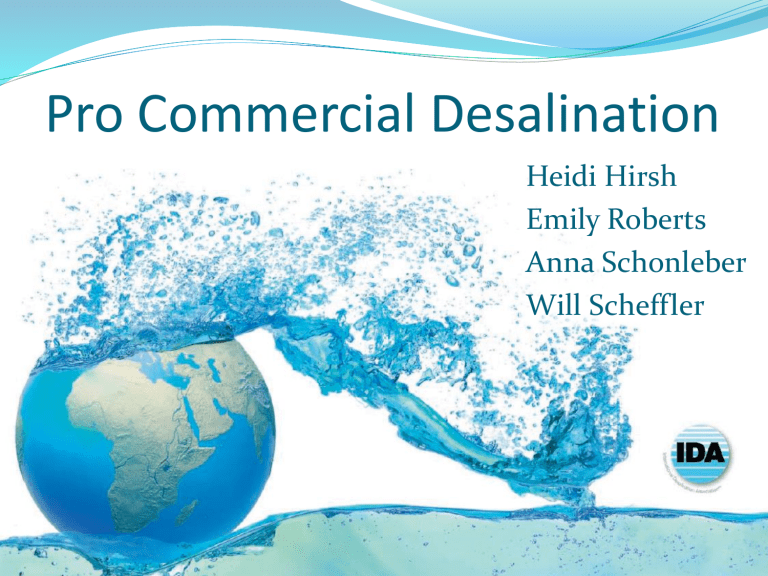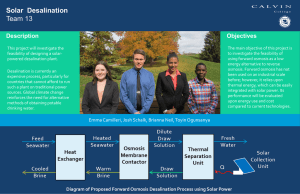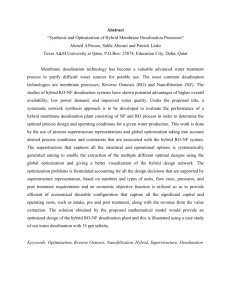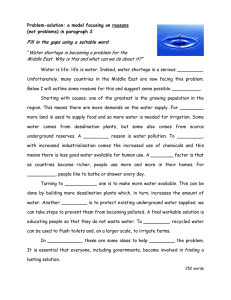
Pro Commercial Desalination Heidi Hirsh Emily Roberts Anna Schonleber Will Scheffler Argument Outline 1. Global Water Crisis (Heidi) 2. Success so far (Emily) 3. Economics (Anna) 4. Marketable byproduct (Will) Global Water Crisis: Demand for Desalination http://www.toonpool.com/cartoons/World%20fresh%20water%20supply_31345 Availability of Freshwater 97.5% of the water on earth is in the ocean. Only 2.5% freshwater 70% is permanently frozen in glaciers 30% is groundwater 0.3% is in rivers and lakes UN Water, 2011 http://www.unwater.org/statistics.html Freshwater Demand by 2025 Scientific American, August 2008 By 2025… Freshwater demand will rise by 2/3 1.8 billion people will be living in countries or regions with absolute water scarcity, and 2/3 of the world population could be under stress conditions. Water withdrawals are predicted to increase by 50% in developing countries, and 18% in developed countries. Science, Aug. 2011 United Nations Water Statistics, 2011 http://www.munnaontherun.com/2008/06/water-crisis.html Desalination Unlimited, steady supply of high-quality water, without impairing natural freshwater ecosystems. Image: http://www.good.is/post/seawater-our-only-hope-for-a-drink/ Desalination Today Nearly 15,000 desalination plants today Provide some 300 million people with water Still less that 2% of total planetary water consumption Explosion of demand in the Middle East and North Africa region Also widely employed in Spain, the Caribbean, and Australia New markets are growing in China, India, Singapore, Chile, and the USA Case Studies There are already 14,451 desalination plants in use world wide These plants produce 59.9 million cubic meters of water per day (15.8 billion gallons of water) Information: the International Desalination Association as of 2009 Co-generation Co-generation uses “duel purpose facilities to produce both electricity and water” Also called CHP for Combined Heat and Power Excess heat from power production is incorporated into the process of thermal water desalination Fossil fuels or nuclear power are often used with desalination plants in the Middle East and North Africa Information: New World Encyclopedia Thermal/Multi Stage Flash Thermal: heated water to boiling point, condensation (pure water) is collected at the top and impurities left behind Reverse Osmosis/Membrane Intake system Membrane Process Pre-treat water Reverse Osmosis membrane Post Treatment Pictures from International Desalination Association video Nuclear Desalination There have been over 15 years of experience with nuclear desalination, mainly in India, Japan, and Kazakhstan In Japan, 8 nuclear reactors are linked to 10 desalination plants India: hybrid Nuclear Desalination Demonstration Project (NDDP) Information: World Nuclear Association India’s Nuclear Desalination Demonstration Project (NDDP) Incorporates thermal (MSF) and reverse osmosis (RO) desalination plants as well as a nuclear power plant “The preheat RO system part of the hybrid plant uses reject cooling seawater from the MSF plant. This allows a lower pressure operation, resulting in energy saving.” Membrane life extended in the RO plant because operated at a lower pressure NDDP “…qualities of water produced are usable for the power station as well as for drinking purposes with appropriate blending.” “The post-treatment is also simplified due to blending of the products from MSF and RO plants.” Information: Journal – Advances in Nuclear Desalination by Dr. Misra PhD from India, Research Associate at Harvard & UCLA World Desalination Plants Economics Increase in technology such as improvements in the use of membranes are increasing efficiency and reducing cost http://hbfreshwater.com/desalination-101/desalination-worldwide Decreasing the use of energy consumption over time is reducing the cost of operation http://hbfreshwater.com/desalination-101/desalination-worldwide Decrease in cost leads to a decrease in price making freshwater more affordable www.tandfonline.com/loi/venv20 Outstanding career opportunities for professionals engaged in water industry, science or engineering. IDA’s Young Leaders Program Provide a forum for communication, networking and exchange of ideas among these emerging leaders and the industry at large. Example: Australia Desalination will provide a secure and predictable supply of freshwater to places such as Australia, who's other source of freshwater is capturing rain water which is highly variable and infrastructure intensive Australia has already implemented this technology successfully, utilizing 3 in-use plants, 3 in progress plants and 1 planned plant By-Product A Marketable By-Product Byproduct references http://www.water-technology.net/projects/tampa/ http://www.desalination.biz/ http://www.desware.net/ Rebuttal Re-mineralization of end product 4 processes to re-mineralize desalinated water: Re-mineralization of end product Water quality for drinking/irrigation Process Comparisons: Re-mineralization of end product Can re-mineralize the water to avoid dietary deficiencies Information: Lenntech (org. created by alumni of Netherlands’ Technical University of Delft; references include US Army, DSM Pharmaceuticals, Universities etc.) Seawater Intake Precautions The impact on a population level is not clear given the naturally high mortality of larval organisms in marine systems. Appropriate screens and low intake velocity on open surface intakes can minimize impingement. Locating intakes away from biologically productive areas can substantially reduce or eliminate entrainment of small planktonic organisms. Underground beach wells Menachem Elimelech, et al. Science Aug. 2011 Brine Impact In the planning phase for Israel’s Ashkelon desalination facility there were concerns about the impact of the brine that the desalination process produces Discharged 1km into the sea Residual dilution Diffuser above seabed Effects: Minimal salinity change Creation of a positive “mini-fishery” microenvironment Tal, Alon. Environmet: Science and Policy for Sustainable Development Sludge Yuma, Arizona Cooperative research and development agreement with Envirock Inc Sludge “Green” concrete mix formulation Reduce operating costs by up to US$ 245,000/year Announcement of the US Bureau of Reclamation on September 21, 2011 National Geographic, January 2008 Precipitation http://www.scientificamerican.com/article.cfm?id=freshwater-crisis-current-situation UNEP: United Nations Environment Program http://www.theglobaleducationproject.org/earth/fresh-water.php?format=print Cost It is true that desalination may be expensive today, but it is a long term solution to the water crisis and as shown, over time the cost will decrease It is possible for the desalination plant to run of renewable energy such as solar or wind for example in Perth, Australia, the plant runs on renewable energy from a nearby wind farm. The increased use of renewable energy will reduce the carbon foot print in Australia Cost It is hard to actually predict the cost of a desalination plant because there is little available information Cost is determined by a lot of different factors such as the capital and operating costs, type of facility, location, feed water, labor, energy, financing, and concentrate disposal which also makes the cost hard to predict Cost Much of the energy use associated with desalination can ultimately be recovered and recycled further lower the cost






